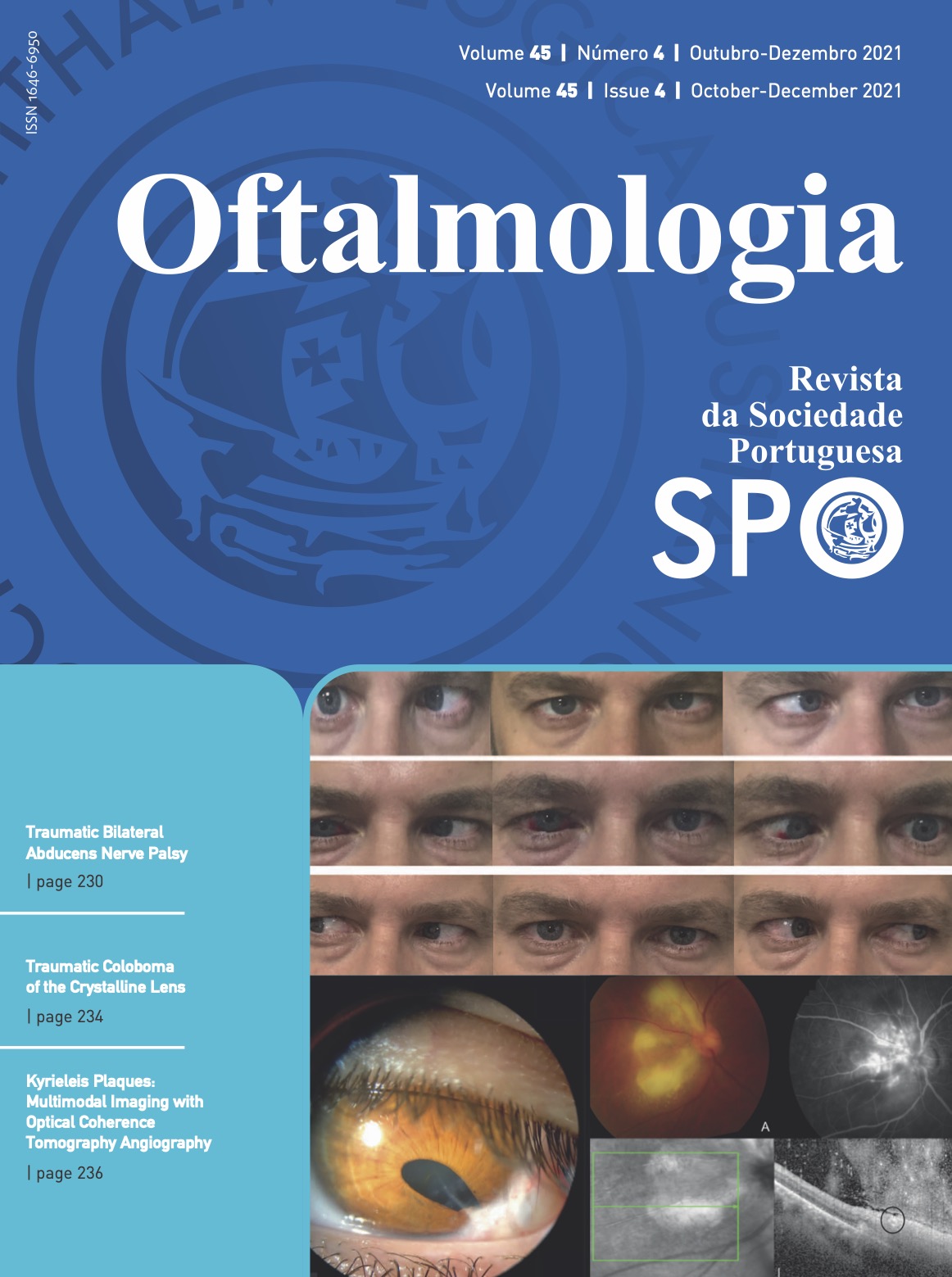Fundus autofluorescence: from basic principles to clinical applications
DOI:
https://doi.org/10.48560/rspo.24546Keywords:
Fluorescein Angiography, Fundus Oculi, Macular Degeneration, Retinal DiseasesAbstract
Autofluorescence (FAF) is a valuable imaging technique in numerous retinal diseases, that may be underutilized in day-to-day practice. We aim to review the basic principles of blue-light autofluorescence and to highlight its clinical utility.
FAF is a rapid and noninvasive imaging technique of the ocular fundus. FAF images reflect the distribution of lipofuscin in the retinal pigment epithelium (RPE), allowing an assessment of RPE function and the detection of atrophic areas. There are various systems for image acquisition, resulting in qualitative and quantitative differences that should be considered upon image interpretation. Changes in FAF signal are observed in numerous diseases. Some present typical autofluorescence patterns that assist in the diagnosis, including age-related macular degeneration (AMD), retinal inherited diseases, inflammatory chorioretinopathies and antimalarials retinopathy. In the last years, studies have demonstrated a role for FAF in monitoring and predicting disease progression, especially in patients with AMD.
FAF is a useful modality both for diagnostic and disease monitoring purposes. Incorporation into the routine assessment of diseases such as AMD should be considered.
Downloads
References
Sepah YJ, Akhtar A, Sadiq MA, Hafeez Y, Nasir H, Perez B, et al. Fundus autofluorescence imaging: Fundamentals and clinical relevance. Saudi J Ophthalmol. 2014;28:111-6. doi: 10.1016/j.sjopt.2014.03.008.
Yung M, Klufas M, Sarraf D. Clinical applications of fundus autofluorescence in retinal disease. Int J Retina Vitreous. 2016;2:12. doi: 10.1186/s40942-016-0035-x.
Keilhauer C, Delori F. Near-infrared autofluorescence imaging of the fundus: visualization of ocular melanin. Ophthalmol Vis Sci. 2006;47:3556-64. doi: 10.1167/iovs.06-0122.
Skondra D, Papakostas T, Hunter R, Vavvas D. Near infrared autofluorescence imaging of retinal diseases. Semin Ophthalmol. 2012;27:202-8. doi: 10.3109/08820538.2012.708806.
Calvo-Maroto A, Esteve-Taboada J, Domínguez-Vicent A, Pérez-Cambrodí R, Cerviño A. Confocal scanning laser ophthalmoscopy versus modified conventional fundus camera for fundus autofluorescence. Expert Rev Med Devices. 2016;13:965-78. doi: 10.1080/17434440.2016.1236678.
Park S, Siringo F, Pensec N, Hong I, Sparrow J, Barile G, et al. Comparison of fundus autofluorescence between fundus camera and confocal scanning laser ophthalmoscope-based systems. Ophthalmic Surg Lasers Imaging Retina. 2013;44:536-43. doi: 10.3928/23258160-20131105-04.
Patel S, Shi A, Wibbelsman T, Klufas M. Ultra-widefield retinal imaging: an update on recent advances. Ther Adv Ophthalmol. 2020;12:2515841419899495. doi: 10.1177/2515841419899495.
Landa G, Rosen R, Pilavas J, Garcia P. Drusen characteristics revealed by spectral-domain optical coherence tomography and their corresponding fundus autofluorescence appearance in dry age-related macular degeneration. Ophthalmic Res. 2012;47:81-6. doi: 10.1159/000324988.
Bindewald A, Bird A, Dandekar S, Dolar-Szczasny J, Dreyhaupt J, Fitzke F, et al. Classification of fundus autofluorescence patterns in early age-related macular disease. Invest Ophthalmol Vis Sci. 2005;46:3309-14. doi: 10.1167/iovs.04-0430.
Batioğlu F, Demirel S, Ozmert E, Oguz Y, Ozyol P. Autofluorescence patterns as a predictive factor for neovascularization. Optom Vis Sci. 2014;91:950-5. doi: 10.1097/OPX.0000000000000321.
Ly A, Nivison-Smith L, Assaad N, Kalloniatis M. Fundus Autofluorescence in age-related macular degeneration. Optom Vis Sci. 2017 Feb;94(2):246-259. doi: 10.1097/OPX.0000000000000997.
Conti T, Ohlhausen M, Hom G, Talcott K, Golshani C, Choudhry N, et al. Comparison of widefield imaging between confocal laser scanning ophthalmoscopy and broad line fundus imaging in routine clinical practice. Ophthalmic Surg Lasers Imaging Retina. 2020;51:89-94. doi: 10.3928/23258160-20200129-03.
Wolf-Schnurrbusch U, Wittwer V, Ghanem R, Niederhaeuser M, Enzmann V, Framme C, et al. Blue-light versus green-light autofluorescence: lesion size of areas of geographic atrophy. Invest Ophthalmol Vis Sci. 2011;52:9497-502. doi: 10.1167/iovs.11-8346.
Holz F, Bindewald-Wittich A, Fleckenstein M, Dreyhaupt J, Scholl H, Schmitz-Valckenberg S. Progression of geographic atrophy and impact of fundus autofluorescence patterns in age-related macular degeneration. Am J Ophthalmol. 2007;143:463-72. doi: 10.1016/j.ajo.2006.11.041.
Batıoğlu F, Gedik OY, Demirel S, Ozmert E. Geographic atrophy progression in eyes with age-related macular degeneration: role of fundus autofluorescence patterns, fellow eye and baseline atrophy area. Ophthalmic Res. 2014;52:53-9. doi: 10.1159/000361077.
McBain V, Townend J, Lois N. Fundus autofluorescence in exudative age-related macular degeneration. Br J Ophthalmol. 2007;91:491-6. doi: 10.1136/bjo.2006.095109.
Camacho N, Barteselli G, Nezgoda J, El-Emam S, Cheng L, Bartsch D, et al. Significance of the hyperautofluorescent ring associated with choroidal neovascularisation in eyes undergoing anti-VEGF therapy for wet age-related macular degeneration. Br J Ophthalmol. 2015;99:1277-83. doi: 10.1136/bjophthalmol-2014-306226.
Sawa M, Ober M, Spaide R. Autofluorescence and retinal pigment epithelial atrophy after subretinal hemorrhage. Retina. 2006;26:119-20. doi: 10.1097/00006982-200601000-00025.
Gabai A, Veritti D, Lanzetta P. Fundus autofluorescence applications in retinal imaging. Indian J Ophthalmol. 2015;63:406-15. doi: 10.4103/0301-4738.159868.
von Rückmann A, Fitzke F, Fan J, Halfyard A, Bird A. Abnormalities of fundus autofluorescence in central serous retinopathy. Am J Ophthalmol. 2002;133:780-6. doi: 10.1016/s0002-9394(02)01428-9.
Boon C, Jeroen KB, Keunen J, Hoyng C, Theelen T. Fundus autofluorescence imaging of retinal dystrophies. Vision Res. 2008;48:2569-77. doi: 10.1016/j.visres.2008.01.010.
Oishi A, Miyata M, Numa S, Otsuka Y, Oishi M, Tsujikawa A. Wide-field fundus autofluorescence imaging in patients with hereditary retinal degeneration: a literature review. Int J Retina Vitreous. 2019;5(Suppl 1):23. doi: 10.1186/s40942-019-0173-z.
Fleckenstein M, Charbel IP, Fuchs H, Finger R, Helb H, Scholl H, et al. Discrete arcs of increased fundus autofluorescence in retinal dystrophies and functional correlate on microperimetry. Eye. 2009;23:567-75. doi: 10.1038/eye.2008.59
Querques G, Zerbib J, Georges A, Massamba N, Forte R, Querques L, et al. Multimodal analysis of the progression of Best vitelliform macular dystrophy. Mol Vis. 2014;20:575-92.
Parodi M, Iacono P, Campa C, Del Turco C, Bandello F. Fundus autofluorescence patterns in Best vitelliform macular dystrophy. Am J Ophthalmol. 2014;158:1086-92. doi: 10.1016/j.ajo.2014.07.026.
Pandya H, Robinson M, Mandal N, Shah V. Hydroxychloroquine retinopathy: A review of imaging. Indian J Ophthalmol. 2015;63:570-4. doi: 10.4103/0301-4738.167120.
Marmor M, Kellner U, Lai T, Melles R, Mieler W. Recommendations on Screening for Chloroquine and Hydroxychloroquine Retinopathy (2016 Revision). Ophthalmology. 2016;123:1386-94. doi: 10.1016/j.ophtha.2016.01.058.
Yusuf I, Sharma S, Luqmani R, Downes S. Hydroxychloroquine retinopathy. Eye. 2017;31:828-45. doi: 10.1038/eye.2016.298.
Raven M, Ringeisen A, Yonekawa Y, Stem M, Faia L, Gottlieb J. Multi-modal imaging and anatomic classification of the white dot syndromes. Int J Retina Vitreous. 2017;3:12. doi: 10.1186/s40942-017-0069-8.
Meleth A, Sen H. Use of fundus autofluorescence in the diagnosis and management of uveitis. Int Ophthalmol Clin. 2012;52:45-54. doi: 10.1097/IIO.0b013e3182662ee9.
Yeh S, Forooghian F, Wong W, Faia L, Cukras C, Lew J, et al. Fundus autofluorescence imaging of the white dot syndromes. Arch Ophthalmol. 2010;128:46-56. doi: 10.1001/archophthalmol.2009.368.
Palmer E, Gale J, Crowston J, Wells A. Optic Nerve Head Drusen: An Update. Neuroophthalmology. 2018;42:367-84. doi: 10.1080/01658107.2018.1444060.
Downloads
Published
How to Cite
Issue
Section
License
Copyright (c) 2021 Revista Sociedade Portuguesa de Oftalmologia

This work is licensed under a Creative Commons Attribution-NonCommercial 4.0 International License.
Do not forget to download the Authorship responsibility statement/Authorization for Publication and Conflict of Interest.
The article can only be submitted with these two documents.
To obtain the Authorship responsibility statement/Authorization for Publication file, click here.
To obtain the Conflict of Interest file (ICMJE template), click here





